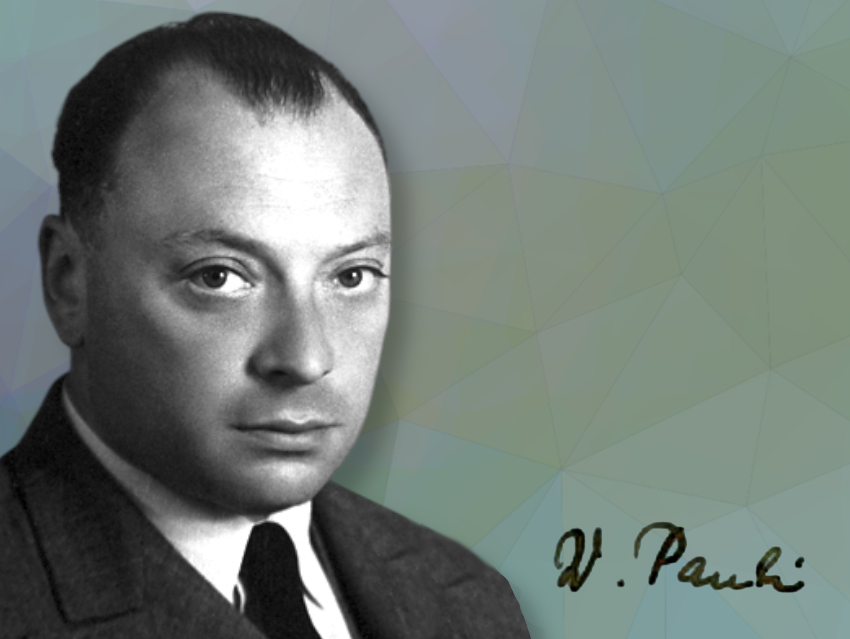Wolfgang Pauli is considered one of the most significant physicists of the 20th century. He received the 1945 Nobel Prize in Physics for his “decisive contribution through his discovery of a new law of Nature, the exclusion principle or Pauli principle”.
🔬 Pauli Principle
When studying the electron configuration of elements, the Pauli exclusion principle emerges, stating that no two electrons can have the same set of four quantum numbers.
The Pauli exclusion principle helps to explain a variety of physical phenomena. A particularly important consequence of the principle is the electron shell structure of atoms and the way atoms share electrons, which explains the diversity of chemical elements and their chemical combinations.
🎂 125 Years of Wolfgang Pauli
This principle was introduced by Wolfgang Pauli, who was born 125 years ago on April 25, 1900, in Vienna, Austria.
🧮 A Mathematical Prodigy
Even in school, Pauli was recognized as a mathematical genius. In 1919, he began studying physics under Arnold Sommerfeld (1868–1951) in Munich, Germany. Incredibly, just two years later, in 1921, he earned his doctorate summa cum laude with a dissertation on the hydrogen molecular ion.
🏛️ Academic Career
From 1923 to 1928, Pauli was a professor in Hamburg, Germany, before moving to ETH Zurich, Switzerland, in 1928, but was working in the U.S. frim time to time. After the annexation of Austria by Nazi Germany, he automatically became a German citizen; his applications for Swiss citizenship were rejected twice.
🇺🇸 Years in the United States
In the U.S., he taught at various institutions, partially funding himself through a Rockefeller Fellowship. He became a U.S. citizen in 1946 but chose to return to his professorship at ETH Zurich in the same year. Although initially his professorship was kept open for him, there was resistance due to his absence, and influential figures in Switzerland sought his dismissal. This resistance only subsided when it became known that he would receive the Nobel Prize.
In 1949, he was granted Swiss citizenship.
⚡ Feared but Brilliant
Pauli was notorious for his sharp, often ruthless criticism—even towards friends and renowned scientists. The only person exempt from his critiques was his mentor, Arnold Sommerfeld.
🏆What is Pauli Best Known For?
Wolfgang Pauli made numerous significant contributions to modern physics, particularly in quantum mechanics. His perfectionism often led him to hesitate before publishing, instead sharing his results through intense correspondence with colleagues such as Niels Bohr (1885–1962), Werner Heisenberg (1901–1976), and Pascual Jordan (1902–1980). He is best known for:
1920: 🧠 published groundbreaking article on relativity theory in the Enzyklopädie der mathematischen Wissenschaften, which established his reputation in the Sommerfeld school.
1924: 🔬 discovering nuclear spin to explain hyperfine structure of atomic spectra.
1925: ⚛️ introducing a new degree of freedom in quantum mechanics, leading to the identification of electron spin and the formulation of the Pauli exclusion principle, a fundamental contribution to quantum mechanics. Later this was named Pauli Priciple.
1926: 🔎 solving the hydrogen atom case in Heisenberg’s matrix mechanics, contributing significantly to the acceptance of Heisenberg’s theory.
1927: 🔢 introducing Pauli matrices to describe electron spin and contributing to the theory of paramagnetism in condensed matter physics.
1930: 🌌 postulating the neutrino to conserve energy and momentum in beta decay.
1933: 📚 writing a volume on the general principles of wave mechanics for the Handbuch der Physik.
1930s-1940s: 💥 pioneering work on quantum field theory, collaborating with Heisenberg, Weisskopf, and Jordan, and developig the Pauli-Villars regularization to handle infinities in quantum field theory.
1940: 🎓 proving the spin-statistics theorem in relativistic quantum field theory, offering deeper insight into the Pauli exclusion principle.
1946: ⚛️ writing about meson theory and nuclear forces.
1955: 🔄 proving the CPT symmetry theorem, showing that combined operations of space reflection (parity transformation; P), charge conjugation (C), and time reversal (T) form a symmetry in relativistic quantum field theory.
Wolfgang Pauli died on Dezember 15, 1958 in Zurich, Switzerland.
Sources
- Gisela Boeck, Von Schuljahr zu Schuljahr – Höhepunkte der Chemiegeschichte, Chemkon 2024, 31(3), 119–121. https://doi.org/10.1002/ckon.202400014
- Wolfgang Pauli und die moderne Physik, ETH Zürich (accessed February 26, 2025)
Wolfgang Pauli is the answer to Guess the Chemist (160)




